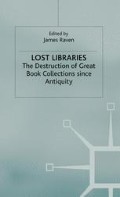Abstract
More than 700 monasteries were dissolved under emperor Joseph II in the lands of the Habsburg monarchy between 1782 and 1787. The number of regular clergy declined from an estimated 25,000 to just over 11,000.1 With dissolutions proceeding in distinct phases, this extraordinary undertaking brought about an immense movement of books and proved to be of critical importance in the history of both private and public libraries in Austria. Today’s public libraries, in particular, derive their basic stock of manuscripts and incunables from the dissolved monastic libraries.
Access this chapter
Tax calculation will be finalised at checkout
Purchases are for personal use only
Preview
Unable to display preview. Download preview PDF.
Notes
P. G. M. Dickson, ‘Joseph II’s Reshaping of the Austrian Church’, Historical Journal, 36 (1993): 89–114 (p. 101).
Elisabeth Kovács, ‘Josephinische Klosteraufhebungen 1782–1789’, in Österreich zur Zeit Kaiser Josephs II (Vienna: Amt der Niederösterreichischen Landesregierung, 1983), pp. 169–73;
Ludwig Raber, Die österreichischen Franziskaner im Josefinismus, Maria Enzersdorf: Zentralbibliothek der Franziskaner [1983];
Karl Gutkas, Kaiser Joseph II: Eine Biographie (Vienna: Zsolnay, 1989), pp. 303–10;
Rudolph C. Blitz, ‘The Religious Reforms of Joseph II (1780–1790) and their Economic Significance’, The Journal of European Economic History, 18: 3 (1989): 583–94; Dickson, ‘Joseph II’s Reshaping of the Austrian Church’, pp. 89–114;
Floridus Röhrig, ‘Die Klosteraufhebungen Josephs II’, in 11.–13. Symposion der Internationalen Kommission für vergleichende Kirchengeschichte Subkommission Österreich (Vienna: Institut für Kirchengeschichte, 1994), pp. 114–22;
T. C. W. Blanning, Joseph II (Harlow: Longman, 1994);
Derek Beales, ‘Joseph II and the Monasteries of Austria and Hungary’, in N. Aston, ed., Religious Change in Europe, 1650–1914: Essays for John McManners (Oxford: Oxford University Press, 1997), pp. 161–84.
Simon Laschitzer, ‘Die Verordnungen über die Bibliotheken und Archive der aufgehobenen Klöster in Österreich’, Mitteilungen des Instituts für österreichische Geschichtsforschung, 2 (1881): 401–40 and ‘Geschichte der Klosterbibliotheken und Archive Kärntens zur Zeit ihrer Aufhebung unter Kaiser Joseph II’, Carinthia, 73 (1883): 129–48, 161–87, 193–208.
Anton Schubert, ‘Die ehemaligen Bibliotheken der von Kaiser Josef II. aufgehobenen Mönchsklöster in Mähren und Schlesien, sowie die der Exjesuiten zu Teschen und Troppau’, Zentralblatt für Bibliothekswesen, 17 (1900): 321–36, 401–23, 449–68 (pp. 322–4).
Franz Karnthaler, ‘Das Schicksal der Tiroler Klosterbibliotheken in den Jahren 1773–1790’, Biblos, 5 (1956): 123–9;
Eva Verona, ‘Die Aufhebung der kroatischen Klosterbibliotheken unter Josef II’, in: Festschrift Josef Stummvoll, ed. by Josef Mayerhöfer and Walter Ritzer, vol. 1 (Vienna: Hollinek, 1970), pp. 439–49;
Christine Tropper, ‘Schicksale der Büchersammlungen niederösterreichischer Klöster nach der Aufhebung durch Joseph II. und Franz (II) I’, Mitteilungen des Instituts für österreichische Geschichtsforschung, 91 (1983): 95–150.
Cf. Rudolf Hittmayr, Der Josefinische Klostersturm im Land ob der Enns (Freiburg i. B.: Herder, 1907), p. 285;
Konrad Schiffmann, Die Handschriften der öffentlichen Studienbibliothek in Linz (unpublished manuscript at the Oberösterreichische Landesbibliothek, Linz 1935), pp. 22–5; Mittelalterliche Bibliothekskataloge Österreichs, vol. 5: Oberösterreich, ed. by Herbert Paulhart (Vienna: Böhlau, 1971), pp. 116–17.
I wish to thank Prof. Derek Beales and Prof. James Raven for their valuable comments and suggestions. For Josephinism, see Derek Beales, ‘Joseph II. und der Josephinismus’, in Helmut Reinalter and Harm Klueting, eds, Der aufgeklärte Absolutismus im europäischen Vergleich (Vienna: Böhlau, 2001): 35–53.
Walter Neuhauser, Beiträge zur Bibliotheksgeschichte der Kartause Schnals, Analecta Cartusiana, 83 (1980): 48–126.
Johann Duellinger, Catalogus librorum qui publicae auctioni exponentar in Bibliotheca universitatis Oenipontanae VII. Maii et sequent. M.DCC.XCII (Innsbruck: Wagner, 1792), University Library Innsbruck n. 30.354; cf.
Sieglinde Sepp, ‘Die Bibliothek entsteht und wächst’, in Vom Codex zum Computer: 250 Jahre Universitätsbibliothek Innsbruck (Innsbruck: Tiroler Landesmuseum Ferdinandeum, 1995), p. 42.
See Benedikt Wagner, ‘Der Religionsfonds versteigert eine alte Stiftsbibliothek’, in Translatio Studii: Manuscript and Library Studies honoring Oliver L. Kapsner (Collegeville, Minnesota: St John’s University Press, 1973), pp. 235–43.
Franz von Krones, Geschichte der Karl Franzens-Universität in Graz (Graz: Karl Franzens-Universität, 1886), p. 488.
See Brunhilde Hoffmann, Die Aufhebung der Kartause Gaming, Analecta Cartusiana, 58 (1981): 45–8, 91–101.
Cf. Kurt Holter, Buchkunst — Handschriften — Bibliotheken: Beiträge zur mitteleuropäischen Buchkultur vom Frühmittelalter bis zur Renaissance, ed. by Georg Heilingsetzer and Winfried Stelzer, vol. 2 (Linz: Oberösterreichischer Musealverein 1996), p. 893.
Hermann Hauke, ‘Die Bedeutung der Säkularisation für die bayerischen Bibliotheken’, in Glanz und Ende der alten Klöster: Säkularisation im bayerischen Oberland 1803, ed. by Josef Kirmeier and Manfred Treml (München: Haus der Bayerischen Geschichte, 1991), pp. 87–97 (p. 87).
Jeffrey Garrett, ‘Aufhebung im doppelten Wortsinn: The Fate of Monastic Libraries in Central Europe, 1780–1810’, Verbum Analecta Neolatina, 2 (1999): 15–27 (p. 26).
Handbuch der historischen Buchbestände in Österreich, ed. by Helmut W. Lang, 4 vols (Hildesheim: Olms, 1994–97).
Editor information
Editors and Affiliations
Copyright information
© 2004 Palgrave Macmillan, a division of Macmillan Publishers Limited
About this chapter
Cite this chapter
Buchmayr, F. (2004). Secularization and Monastic Libraries in Austria. In: Raven, J. (eds) Lost Libraries. Palgrave Macmillan, London. https://doi.org/10.1057/9780230524255_8
Download citation
DOI: https://doi.org/10.1057/9780230524255_8
Publisher Name: Palgrave Macmillan, London
Print ISBN: 978-1-349-51530-1
Online ISBN: 978-0-230-52425-5
eBook Packages: Palgrave History CollectionHistory (R0)

